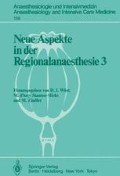Abstract
Excellent analgesia during and after upper abdominal surgery can be obtained by a segmental epidural blockade which includes the dermatomes T5 and L3. To achieve this segmental spread with a minimal amount of local anaesthetic for both intra- und postoperative use, the placement of an epidural catheter at the midpoint of the nerve supply to the abdominal wall in the thoracic region is essential [3—5]. Many anaesthetists, however, fear damage to the spinal cord when using the thoracic approach and they prefer therefore to make their injections into the lumbar epidural space below the level of termination of the spinal cord. The experience that over 4,500 epidural anaesthetisations were performed safely in the midthoracic region at the Anaesthesia Department of the University of Düsseldorf lends support to the opinion of Dawkins et al. [4], that this notion has been exaggerated, and anaesthetists could be advised to overcome their reluctance to use a midthoracic approach to the epidural space.
Access this chapter
Tax calculation will be finalised at checkout
Purchases are for personal use only
Preview
Unable to display preview. Download preview PDF.
References
Bromage PR (1955) Spirometry in assessment of analgesia after abdominal surgery. Br Med J 2: 589
Bromage PR (1969) The physiology and pharmacology of epidural blockade. In: Bonica JJ (ed) Regional anesthesia chapt 3. Clin Anesth 2: 45
Bromage PR (1978) Epidural analgesia. Saunders, Philadelphia
Dawkins CJM, Steel GC (1971) Thoracic extradural (epidural) block for upper abdominal surgery. Anaesthesia 26: 41
Durrans SF (1947) High extradural segmental block. Anaesthesia 2: 106
Kehlet H, Brandt MR (1980) Effects of neurogenic blockade on the endocrine-metabolic response to surgery. In: Wüst HJ, Zindler M (eds) Neue Aspekte der Regionalanaesthesie 1: Wirkung auf Herz, Kreislauf und Endokrinium. Postoperative Periduralanalgesie. vol 124, Anaesthesie und Wiederbelebung. Springer, Berlin Heidelberg New York, pp 112–118
Modig J, Hjelmstedt Å, Sahlstedt B, Maripuu E, Saldeen T (1981) The influence of epidural versus general anaesthesia on the incidence of thromboembolism after total hip replacement. In: Wüst HJ, Zindler M (eds) Neue Aspekte in der Regionalanaesthesie 2, vol 138, Anaesthesiology and intensive care medicine. Springer, Berlin Heidelberg New York, pp 121–127
Moore DC, Batru MS (1981) The components of an effective test dose prior to epidural block. Anesthesiology 55: 693
Rao TLK, El-Etr AA (1981) Anticoagulation following placement of epidural and subarachnoid catheters: an evaluation of neurological sequelae. Anesthesiology 55: 618
Siepmann HP, Wüst HJ, Liebau W (1980): Postoperative Periduralanaesthesie (Technik und Indikationen) In: Wüst HJ, Zindler M, (eds) Neue Aspekte in der Regionalanaesthesie 1, vol 124, Anaesthesiologie und Intensivmed. Springer, Berlin Heidelberg New York, pp 135–138
Wüst HJ, Florack G, Sandmann W, Lennartz H (1976) Kreislaufveränderungen während und nach aorto-femoralen Bypassoperationen (AFB) unter kontinuierlicher Epiduralanaesthesie. Langenbecks Arch Chir 342: 594
Wüst HJ, Sandmann W, Spirgatis G (1978) Gamma-Hydroxybuttersäure als Adjuvans bei der konti- nuierlichen thorakalen und lumbalen Epiduralanaesthesie. In: Frey R (ed) Neue Untersuchungen mit Gamma-Hydroxybuttersäure, vol 110, Anaesthesiology and intensive care medicine. Springer, Berlin Heidelberg New York, pp 123–130
Wüst HJ (1983) Der Einflufi des Anaesthesieverfahrens — NLA, Halothan und thorakale Epiduralanaesthesie — und der Operation auf die Herzkreislauffunktion wahrend aorto-femoraler Bypass- Operationen. Med. Habilitationsschrift, Düsseldorf. Springer, Berlin Heidelberg New York
Wüst HJ, Florack G, Sandmann W, Riehter O, Lemacher W (1980a) A comparison of cardiovascular effects of neurolept halothane or continuous thoracic epidural anaesthesia in patients undergoing an aortofemoral bypass operation. In: Wüst HJ, Zindler M (eds) Neue Aspekte in der Regionalanaesthesie 1, vol 124, Anaesthesiology and intensive care medicine. Springer, Berlin Heidelberg New York, p 12
Wüst HJ, Godehard E, Gunther D, Sandmann W, Zumfelde L (1980) Modifying effects of anaesthesia on the postoperative pulmonary function in patients undergoing an aortofemoral bypass operation. In: Wüst HJ, Zindler M (eds) Neue Aspekte in der Regionalanaesthesie 1, vol 124, Anaesthesiology und Intensivmedizin. Springer, Berlin Heidelberg New York, pp 175–179
Wüst HJ, Liebau W, Riehter O, Strasser K (1980c) Tachyphylaxie bei kontinuierlicher thorakaler Epiduralanalgesie mit Bupivacain 0,125% und 0,25%. Anaesthesiol Intensiv Notfallmed 15: 159
Wüst HJ, Sandmann W, Riehter O (1981) Regional anaesthesia pros and cons. In: Riigheimer E, Zindler M (eds) Anesthesiology. Excerpta Medica Int Congress Series, Amsterdam p 538
Wüst HJ, Sandmann W, Florack G (1981) Die Kreislaufwirkung von Diazepam, Etomidate und Gamma-hydroxy-Buttersäure während kontinuierlicher Epiduralanaesthesie in: Wüst HJ, Zindler M (eds) Neue Aspekte in der Regionalanaesthesie 2, vol 138, Anaesthesiology and intensive care medicine. Springer, Berlin Heidelberg New York, p 79
Wüst HJ (1983) Epiduralanaesthesie und Antikoagulantien, Swiss Med 6a: 69
Editor information
Editors and Affiliations
Rights and permissions
Copyright information
© 1984 Springer-Verlag Berlin Heidelberg
About this chapter
Cite this chapter
Wüst, H.J. (1984). Techniques and Indications of Thoracic Epidural Analgesia. In: Wüst, H.J., Zindler, M., d’Arcy Stanton-Hicks, M. (eds) Neue Aspekte in der Regionalanaesthesie 3. Anaesthesiologie und Intensivmedizin Anaesthesiology and Intensive Care Medicine, vol 158. Springer, Berlin, Heidelberg. https://doi.org/10.1007/978-3-642-69453-0_3
Download citation
DOI: https://doi.org/10.1007/978-3-642-69453-0_3
Publisher Name: Springer, Berlin, Heidelberg
Print ISBN: 978-3-540-13023-9
Online ISBN: 978-3-642-69453-0
eBook Packages: Springer Book Archive

